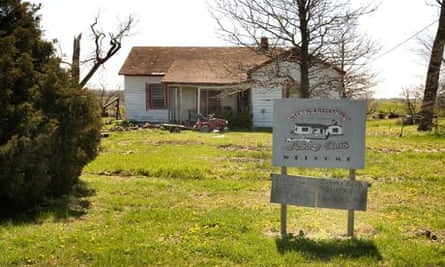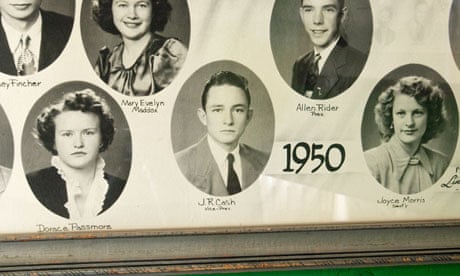With its white leather sofas, fake fur upholstery and green shag-pile carpet that lines even the ceiling of the legendary "Jungle Room", nobody could accuse Elvis Presley's home, Graceland, of being in good taste. But it certainly pulls the crowds: more than 600,000 visitors flock to the Memphis mansion every year.
Fifty miles away, across the Mississippi river in Arkansas, a beat-up, Depression-era farming community is hoping to emulate that success. The starting point for the tiny settlement of Dyess's ambitions could not be further from Elvis's opulent home – a delapidated, single-storey wooden farmstead, located along a dirt road on the edge of town.
But it has a secret ingredient: a music legend of its own. Johnny Cash, the Man in Black, spent his childhood in that house, living in Dyess from 1934 through to the 50s. Now, nearly a decade after his death, Cash's family home is being returned to its original state as the anchor attraction of a $10m tourist project on the back of the singer's global celebrity.
There will, however, be one major difference from the Elvis mansion. Just as Dyess was born out of a social experiment to give people hit by the Depression, like Cash's parents, a second chance, the hope is that the Cash connection will give the entire town and its population of 500 a fresh start, transforming the dusty delapidated streets into a living museum of the era. Or as the people behind the plan call it, a "socially responsible Graceland".
"This hangs on the back of the town, the period and the people," says AJ Henson, one of Cash's closest childhood friends, who remembers his pal better as simply JR.
Unlike the 1950s when Henson couldn't wait to leave, the now 81-year-old longs for every return trip to Dyess. He highlights what it instilled: that hard work can pay off. "We got a house and land on credit and had to pay for them. It is the kind of welfare I wish we had today, the kind of benefits we had to work for ... That is a good lesson for the people of today. If you knew the people that grew up there, they were dirt poor and most did well in life. It is amazing what they became."
Work on the project is already well under way, with the first phase due to open in September. The house was purchased from its last owner using grant money secured by Arkansas State University. The structure's foundations, badly damaged by what locals popularly refer to as the region's gumbo-like earth, have already been relaid, while the roof has been replaced and the exterior walls have been given a facelift.
Authentic furnishings and appliances have been sourced, and Cash's surviving siblings, Joanne and Tommy, have been enlisted to try to make sure the property bears as authentic a resemblance as possible.
"I, being a woman, know where every table, every lamp, every bed was – even the colors of the walls," says Joanne Cash Yates. "We are rebuilding some of the inside that has been changed over the years, and the foundation of the house has been restored, so now it looks like it did when we lived there."

Their memories are also being tapped to pinpoint the spots where various outbuildings and even trees were positioned relative to the home – the places that helped inspire their brother to pen biographical favourites such as Pickin' Time, about the back-breaking work in the family's cotton fields, and Five Feet High and Rising, a song that charts a famous 1930s flood that inundated most of the Dyess area.
The university projects a massive $10m boost for the wider Dyess area economy and 100 new jobs from up to 50,000 annual visitors. There appears to be solid ground for optimism. Since the 2005 Hollywood biopic of Cash's life, Walk the Line, busloads of domestic and foreign tourists have been rolling into town. The lakeside home where Cash spent his later years, in Hendersonville, Tennessee, burned down shortly after his death, leaving nowhere else for fans to visit.
"This is going to wake the whole place up," says Dyess mayor Larry Sims, relishing rather than dreading the possibility that the town could become overwhelmed.
This is a place, he explains, that has been stuck in a time warp for decades, having spiralled into deep economic decline after the second world war. It was left with some of the most acute poverty in the country. Many never leave their homes. Money is tight. Amid the malaise, some of the residents are still taking some convincing that the plans will even materialise, he says. "It may be chaos for a while, but maybe a good chaos. If we get 30,000 show up in just a few days, it will be hard to handle. But we will do what we can to help."
The colony, formed in 1934 under President Franklin D Roosevelt's New Deal programme, was an experimental agricultural community for the destitute. "There were many of these colonies across the country," says Everett Henson, elder brother of AJ and the unofficial town historian. "Dyess was the only one that had everything … a hospital, cotton gin, four schools, including a high school. It was really something. Before we went there, I had never lived in a house with painted walls on the inside, proper floors." Before, his family lived in a house with sacks covering the window holes. This brand-new structure was luxurious by comparison and "meant a lot to my family," he says. "A lot of people were ashamed of it. But I was really proud for my family."
Once more funds are procured, a walking and biking trail is slated to connect the Cash home with the museum in the centre of town.
"Part of what makes the story at Dyess so compelling is that it is not a shrine to Johnny Cash," says Ruth Hawkins, the Arkansas State University professor in charge of the restoration, "but an authentic look at the historic significance of the community that shaped his formative years and impacted his later music."
That's an ethos Cash might have endorsed. "Even though Johnny was worldwide famous," says his sister Joanne. "He did not look at himself as being someone special. He said to me before he passed away: 'I wonder if no-one would really miss me or really care.' I think he would be overwhelmed."




Comments (…)
Sign in or create your Guardian account to join the discussion